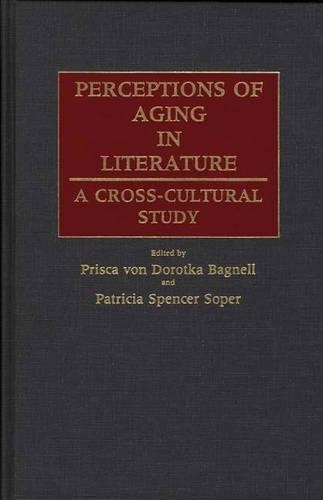
Perceptions of Aging in Literature: A Cross-Cultural Study
(Hardback)
Publishing Details
Perceptions of Aging in Literature: A Cross-Cultural Study
By (Author) P Vn Dorotka Bagnell
By (author) Pat Spencer Soper
Bloomsbury Publishing PLC
Praeger Publishers Inc
25th September 1989
United States
Classifications
Tertiary Education
Non Fiction
809.93354
Physical Properties
Hardback
200
Description
The various norms and values of aging that have been created by humans in the course of history have been largely ignored by gerontologists, who are thought to be more interested in the objective laws that govern science than in the subjective experiences that contribute to the aging process. This thought-provoking study belongs to the genre known as humanistic gerontology and it explores the attitudes toward aging as expressed by society. Outlining the cultural construction of old age and the social and psychological ramifications that are often imposed on the aged by external influences, it focuses on the status and treatment of old age and presents a portrait of aging in a cultural and historical perspective illuminated by diverse national literatures. Unlike any other book on the subject, this volume is an attempt to add to the body of knowledge that helps illustrate, explain, and bridge the dichotomy that still exists between the scientist and the humanist in the field of aging. The various contributors maintain a sensitivity to the continuing paradoxes associated with the aging condition and, using a historical framework, they analyze and interpret national literary conventions. This timely and incisive work examines the aging population as revealed in prominent national or regional literatures including Japan, China, South America, France, Russia, Germany, Austria, Great Britian, the United States, the Middle East, and samples from ancient Greek and Roman literature. Based on previous scholarly research, the volume provides a significant resource that deals with the universalities of the aging condition as expressed in diverse cultures and it extracts common themes and recurring images from the literature of those cultures. Perceptions of Aging in Literature will be read with interest by those engaged in gerontological research in the social and behavioral sciences and the humanities and it will be a welcome addition to all university libraries.
Reviews
. . . This book may be a useful supplement to a gerontology course, and is definitely an essential addition to the academic library. . . .-Clinical Gerontologist
Humanistic gerontology is rapidly gaining curricular validity in higher education. Interdisciplinary research and cross-cultural studies look with increasing interest at the portrayal of aging in diverse national literatures. As the status accorded the elderly in various ancient and modern cultural contexts is perceptible in imaginative literature, gerontology students are turning more and more to prose, poetry, and drama as a database for looking at attitudes toward age and aging. It is in this respect that the nine contributors to the present volume offer useful models on the response to aging in a variety of literary traditions and genres: Classical Greek and Roman, contemporary British and American, French, German and Austrian, Russian, Hispanic American, Arabic, Japanese, and Chinese. The lead article is of particular value and should be required reading for researchers in this field. Coauthored by Jon Hendricks and C.A. Leedham, it describes many of the problems inherent in interpreting historical and cross-cultural literature on aging. It makes clear that the volume can offer no definitive statement on the contingencies and complexities of aging described in world literatures, but serves as an invitation to reflexion and to a continuing exploration of the contexts of others' lives.' Highly recommended for scholars and specialists in humanistic gerontology.-Choice
." . . This book may be a useful supplement to a gerontology course, and is definitely an essential addition to the academic library. . . ."-Clinical Gerontologist
"Humanistic gerontology is rapidly gaining curricular validity in higher education. Interdisciplinary research and cross-cultural studies look with increasing interest at the portrayal of aging in diverse national literatures. As the status accorded the elderly in various ancient and modern cultural contexts is perceptible in imaginative literature, gerontology students are turning more and more to prose, poetry, and drama as a database for looking at attitudes toward age and aging. It is in this respect that the nine contributors to the present volume offer useful models on the response to aging in a variety of literary traditions and genres: Classical Greek and Roman, contemporary British and American, French, German and Austrian, Russian, Hispanic American, Arabic, Japanese, and Chinese. The lead article is of particular value and should be required reading for researchers in this field. Coauthored by Jon Hendricks and C.A. Leedham, it describes many of the problems inherent in interpreting historical and cross-cultural literature on aging. It makes clear that the volume can offer no definitive statement on the contingencies and complexities of aging described in world literatures, but serves as an invitation to reflexion and to a continuing exploration of the contexts of others' lives.' Highly recommended for scholars and specialists in humanistic gerontology."-Choice
Author Bio
PRISCA VON DOROTKA BAGNELL is the Director of Academic Programs, All-University Gerontology Center, Syracuse University. Her previous works include Information Resources in Social Gerontology, Special Collection: Gerontology and Geriatrics, and she assisted in a film on aging made in the Soviet Union. PATRICIA SPENCER SOPER is currently pursuing doctoral studies in composition and rhetoric at Syracuse University where she is an Instructor and Writing Consultant. She has presented papers at national conferences on research in the teaching of writing. She has several works in progress.
